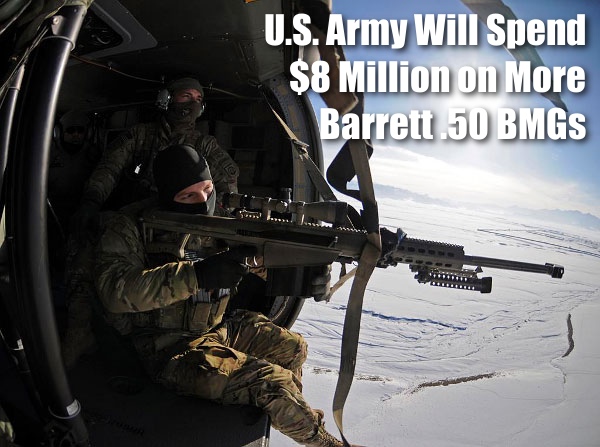$8,000,000 More Barrett 50s for U.S. Army

M107 on duty in Afghanistan with Company F, 2nd Aviation Assault Battalion, 82nd Combat Aviation Brigade’s Pathfinders. U.S. Army photo by Spc. Cody Barber, 11th PAD.
Christmas came early for Barrett Firearms Mfg. Inc. — the company was awarded an $8,000,000 U.S. Army contract for .50 BMG rifles, plus a $3.3 million maintenance support contract for M107s in service. Under the $8 million contract, Barrett will deliver new M107A1, M107, and M82A1M, Caliber .50 Cal Long Range Sniper Rifle systems with scopes, suppressors and spare parts kits. The work is expected to be completed by November 26, 2023, the United States Department of Defense reported this week.
The M107A1 was made “leaner and meaner” back in 2014, with a six-pound weight savings. That’s important to soldiers charged with carrying the big rig in the field. The M107A1 model comes with Lightweight aluminum upper receiver with integral 23″ (58.4 cm) 27 MOA M1913 optics rail, 20″ (50.8 cm) or 29″ (73.7 cm) barrel with fully chrome-lined chamber and bore, 10-round steel magazine with cartridge witness indicators, and anti-corrosive coating.
M107A1 with Quick Detach Large (QDL) Suppressor

$3.3 Million Maintenance Contract for M107s in Service
Barret Firearms Manufacturing, Inc. has also won a $3.3 million maintenance contract for the U.S. Army-issued M107, Caliber .50 Long Range Sniper Rifle system. The 5-year ID/IQ contract was awarded November 27, 2018 and will be available through November 26, 2023. The M107 Rifle System has been fielded by the U.S. Armed Forces for over 15 years.

The Official Rifle of Tennessee
Believe it or not, the Barrett Model 82/M107 is Tennessee’s official state rifle. Barrett’s plant and headquarters are situated in Murfreesboro, Tennessee. The Barrett rifle is a true Tennessee success story — a rifle born from sketches drawn at a dining room table by 26-year-old Ronnie Barrett, who was born, raised, and educated in Tennessee. Using sketches of his design, Barrett worked in a one-bay garage with a tool-and-die maker to build the first prototype.

Watch Jerry Miculek Shoot .50 BMG Offhand. Action Starts at 1:20:














 Russian Lead-Free Primers Tested
Russian Lead-Free Primers Tested
 How the Controversy Arose
How the Controversy Arose





